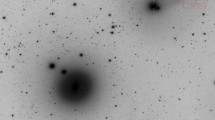Abstract
We report the discovery of a bright, compact ultraviolet source at a projected separation of 1.1 kpc from the known active galactic nucleus (AGN) in Mrk 766 based on AstroSat/UVIT observations. We perform radial profile analysis and derive the UV flux almost free from the nearby contaminating sources. The new source is about 2.5 and 5.6 times fainter than the AGN in the far and near UV bands. The two sources appear as a pair of nuclei in Mrk 766. We investigate the nature of the new source based on the UV flux ratio, X-ray and optical emission. The new source is highly unlikely to be another accreting supermassive black hole in Mrk 766 as it lacks X-ray emission. We find that the UV/optical flux of the new source measured at four different bands closely follow the shape of the template spectrum of starburst galaxies. This strongly suggests that the new source is a compact star-forming region.









Similar content being viewed by others
References
Ballo L., Braito V., Della Ceca R. et al. 2004, ApJ, 600, 634
Cardelli J. A., Clayton G. C., Mathis J. S. 1989, ApJ, 345, 245
Czerny B., Li J., Loska Z., Szczerba R. 2004, MNRAS, 348, L54
Gonzalez Delgado R. M., Perez E. 1996, MNRAS, 278, 737
Junkkarinen V., Shields G. A., Beaver E. A. et al. 2001, ApJ, 549, L155
Kinney A. L., Calzetti D., Bohlin R. C. et al. 1996, ApJ, 467, 38
Komossa S. 2012, Adv. Astron. 2012, https://doi.org/10.1155/2012/364973
Komossa S., Burwitz V., Hasinger G. et al. 2002, Astrophys. J., 582, L15
Komossa S., Zensus J. A. 2014, Proc. Int. Astron. Union, 10, 13–25
Lang D., Hogg D. W., Mierle K., Blanton M., Roweis S. 2010, AJ, 139, 1782
Lusso E., Comastri A., Vignali C. et al. 2010, A&A, 512, A34
Matsui H., Saitoh T. R., Makino J. et al. 2012, ApJ, 746, 26
Merritt D., Milosavljevic M. 2005, Living Rev. Relat. https://doi.org/10.12942/lrr-2005-8
Postma J. E., Leahy D. 2017, PASP, 129, 115002
Schneider P. 2006, Extragalactic Astronomy and Cosmology, An Introduction (Springer, Berlin, Heidelberg). https://doi.org/10.1007/978-3-642-54083-7
Sobolewska M. A., Gierliński M., Siemiginowska A. 2009, MNRAS, 394, 1640
Tandon S. N., Subramaniam A., Girish V. et al. 2017, Astron. J., 154, 128
Tandon S. N., Postma J., Joseph P. et al. 2020, AJ, 159, 158
Vanden Berk D. E., Richards G. T., Bauer A. et al. 2001, AJ, 122, 549
Acknowledgements
This publication uses the UVIT data from the AstroSat mission of the Indian Space Research Organisation (ISRO), archived at the Indian Space Science Data Centre (ISSDC). This publication uses UVIT data processed by the payload operations centre at IIA. The UVIT is built in collaboration between IIA, IUCAA, TIFR, ISRO and CSA. This research has made use of UVIT pipeline (CCDLAB) developed at University of Calgary for UVIT development and science support. The scientific results reported in this article are based in part on observations made by the Chandra X-ray Observatory, data obtained from the Chandra Data Archive. This research is based on observations made with the NASA/ESA Hubble Space Telescope obtained from the Space Telescope Science Institute, which is operated by the Association of Universities for Research in Astronomy, Inc., under NASA contract NAS 5-26555. This research has made use of the python and julia packages. This research has made use of the SIMBAD database, operated at CDS, Strasbourg, France.
Author information
Authors and Affiliations
Corresponding author
Additional information
This article is part of the Special Issue on “AstroSat: Five Years in Orbit”.
Rights and permissions
About this article
Cite this article
Deka, P.P., Dewangan, G.C., Singh, K.P. et al. A pair of UV nuclei or a compact star-forming region near the active nucleus in Mrk 766?. J Astrophys Astron 42, 46 (2021). https://doi.org/10.1007/s12036-021-09695-6
Received:
Accepted:
Published:
DOI: https://doi.org/10.1007/s12036-021-09695-6




